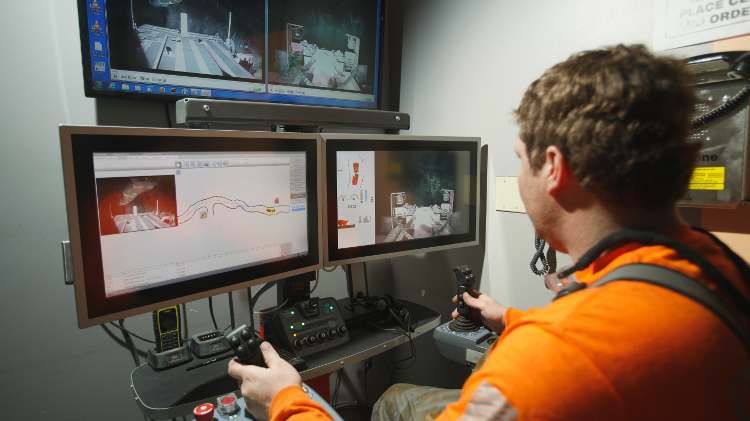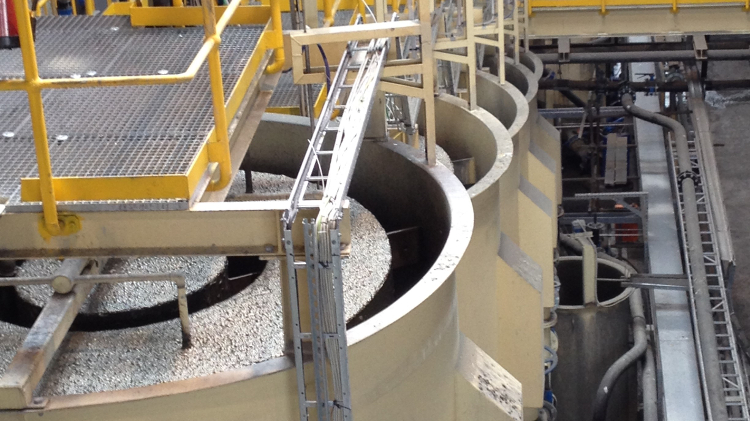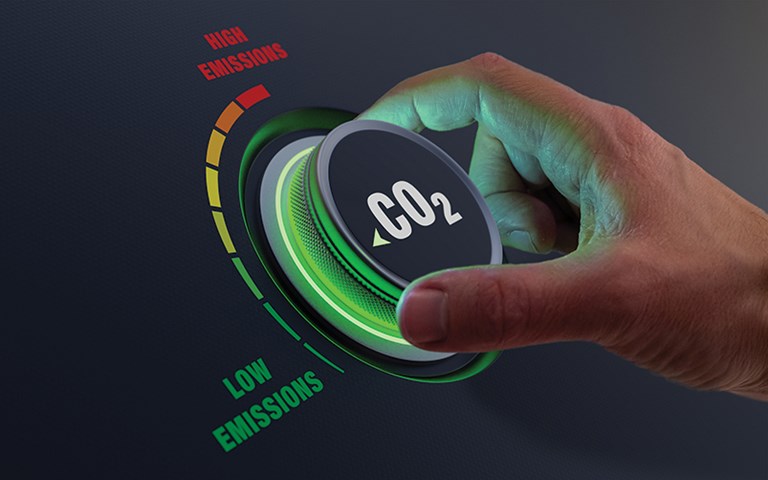When Generation Mining’s Marathon palladium project in northern Ontario is finally built, it will have a smaller site footprint than initially envisioned. The company redesigned its mine plan to include a satellite crusher in the open pit and tailings-storage haulage roads as close to the pit as possible to reduce cycle times. It also included some downhill hauling with in-pit waste storage.
“Some of these things are smart engineering and the right thing to do, but they add the benefit of minimizing your diesel burn and your GHGs [greenhouse gas emissions],” said chief operating officer Drew Anwyll.
Generation Mining also plans to introduce other site optimizations, such as Woodgrove Technologies’ direct flotation reactors at its copper and platinum group mineral (PGM) flotation plant, which will improve the concentrate grade while drawing less power from the Ontario electricity grid. The goal of these changes is to chip away at the site’s future GHG emissions as much as possible, in line with a net-zero future.
Like other mining companies – many of whom have made public pledges to reach net-zero GHG emissions by dates like 2050, including International Council on Mining and Metals (ICMM) members, or 2040 (such as Anglo American) or even 2030 (which is when Fortescue Metals intends to be carbon neutral in Scope 1 and 2 emissions, with Scope 3 following by 2040) – Generation Mining knows that running the cleanest mining operation possible has become a necessity, both from an environmental as well as a business point of view.
Currently, the mining industry represents between four and seven per cent of global GHG emissions and two to three per cent of global carbon dioxide emissions, according to McKinsey & Company, so reducing those numbers will go a long way in halting climate change.
The catch, however, is that since nobody has done this before, nobody knows exactly what they are facing or precisely how to achieve all their goals.
Costly risks ahead
Reaching net zero will require difficult and costly work, made up of major changes and smaller optimization projects, and will require miners to get comfortable with making bets on technology that is not yet commercialized or even piloted. They will also have to get creative when deploying existing technology in new ways or environments.
At Generation, for example, Anwyll said the company has its eye on larger step changes. The company is in conversations with original equipment manufacturers for the consideration of trolley assist for Marathon’s steepest incline, which would also be the trucks’ largest diesel draw. The company has also been discussing battery-powered vehicles as well as those powered by hydrogen fuel cells. But, according to Anwyll, there are a lot of factors to consider before signing the purchase order.
“For trolley assist, there’s a lot more electrical infrastructure you have to put in and the cost of the equipment is slightly higher,” he said. “What we’re talking with the OEMs and trying to be creative with them about – and they’re pretty receptive, to be honest – is how we can have a project that… starts with a certain fleet and how we can change it out at mid-life without having to buy a new fleet. Those challenges genuinely exist.”
Related: As miners commit to reducing their carbon footprints, the scope of that commitment continues to grow
Planning for changes and implementing upgrades tends to increase the cost of doing business.
While the price varies, McKinsey estimated an average 25-million tonne run-of-mine facility that aimed to reach net zero between 2030 and 2040 would incur between US$100 million and US$130 million in transition costs.
“We as an industry have to be willing to take on a bit of that risk, and we have to have the right culture,” said Brian Mashford, mining, minerals and metals business leader at Stantec. “The risk can be managed, but we have to be able to move that forward.”
Building the road
For all the companies that have released ambitious targets in the past year or two, Mashford said many are still figuring out the path to meet them. “What the industry is faced with right now is having great targets to achieve, but not well-defined plans. They understand they have to get there but don’t know how to, and that’s where we’re helping clients right now.”
Theo Yameogo, mining and metals leader at EY, said a significant part of those plans is ensuring miners have the “right talent, systems and technology” to achieve their goals, including hiring for new expertise and having rigorous, third-party validated data on site emissions.
For Yamana Gold, its planning work revealed good news. The company started 2021 by announcing it would bring its GHG emissions in line with the Paris Agreement’s standard two-degree-Celsius warming scenario by 2030 and set an aspirational target of net zero by 2050. By December, Yamana significantly upped its ambition, releasing GHG abatement targets that promised to meet the 1.5-degree Celsius increase limit compared to pre-industrial levels and committed to annual emissions reductions of 4.2 per cent until 2030. The change was a result of evaluating its baseline emissions and testing out three scenarios – two degrees Celsius, well below two degrees Celsius, and 1.5 degrees Celsius.
Craig Ford, Yamana’s senior vice-president of health, safety and sustainable development, said the company’s emissions forecast indicate it will not cross the 1.5 degree Celsius curve until the end of 2025, meaning “we’ve got a little bit of time to…understand the cost better, and the opportunities.” The company has a “preliminary view” of the “modest” investments it expects to make, ranging from battery electric vehicle (BEV) technology and renewable-power purchases to energy-efficiency projects.
“Until we went through [the planning and analysis efforts], we didn’t know how things were really going to work,” Ford said. “I’m really pleased with where we are and what the future holds for our ability to meet what, at the beginning of 2021, we thought was an ambitious target.”
Plugging in
Each mine will face site-specific requirements – such as heating at northern mines, smelters with natural gas- or propane-fired dryers, ventilation for underground operations and fugitive methane emissions at coal mines – but all operations have two major GHG sources in common: nonrenewable power and diesel-powered haul fleets. A June 2021 report from McKinsey estimated between 40 and 50 per cent of the sector’s CO2 emissions come from equipment diesel use, and another 30 to 35 per cent from nonrenewable electricity sources.
Emily Thorn Corthay, founder and CEO at Thorn Associates, an energy and carbon management consulting firm, noted companies with operations in jurisdictions that have close to zero-carbon grids, or access to power purchase agreements (PPAs) with independent producers, already have a leg up. Off-grid, ultra-remote mines, particularly in the North, will face a much bumpier road to decarbonizing. Wind power is possible, and small modular reactors hold promise but are not yet commercially available.
Yamana has renewable grid power at its Wasamac project in Quebec, and has PPAs for its Minera Florida, Jacobina and El Peñon operations; about 85 per cent of the company’s gold equivalent ounces will be produced with renewable energy by the end of 2022. The company’s Cerro Moro gold and silver mine in southern Argentina represents its largest unrenewable power challenge: the site is entirely diesel-powered due to its remote location. In 2022 the company will evaluate the possibility of connecting Cerro Moro to the country’s grid or establishing a wind project at the site.
Ford said he saw decarbonizing the site’s power as “one of several compelling options” for the company to meet and exceed its 2030 goals.
But even in provinces or countries with plentiful renewable power, miners could soon face stiff competition for grid access as other industries make their own net-zero transitions. According to a December report from Clean Energy Canada (CEC) at Simon Fraser University, Canada will need twice as much clean energy by 2050 to fully decarbonize the economy.
In the short term, the country will need to clean up existing fossil-fuel sources through carbon capture and storage or bring new projects online to replace them entirely, said Mark Zacharias, the report’s author and a special advisor at CEC. In the long term, “there will be enormous need for net new electricity generation that’s non-emitting” to accommodate new and expanded grid users. (“Net new” refers to building enough capacity not just to replace fossil-fuel powered generating stations, but to add to the overall available power.)
Charging up
Nowhere is the promise and risk of new technologies more evident than in no-carbon fleets. While BEV use has grown significantly in underground operations, large battery- or hydrogen fuel cell-powered haul trucks for open-pit mines are still in the pilot stage. BEVs for all operations typically require additional infrastructure expenses and changes to mine design, in addition to higher upfront vehicle costs.
“It’s a bit of a challenge right now,” Ford said. Yamana is looking at incorporating BEVs at in-development operations such as Wasamac and Odyssey. “It’s not commercialized to a degree we want to see. But it’s coming.”
Mining companies are increasingly partnering with suppliers to test new equipment in their operations to ensure the technology is mine-ready within the next 10 years, Mashford said.
But the fleet calculation is particularly difficult for junior companies. “[Majors] have the ability to look at slightly longer payback periods than a junior does, than a company like Generation has,” Anwyll said. “It really challenges the commitment to getting to zero. We have to be a bit more creative and focused on it.”
For companies that can’t yet commit to BEVs, biodiesel is a “good stepping stone in the journey that can get you a decent part of the way,” said Thorn Corthay. However, the fuel, which is made out of canola oil, recycled oils, animal fats, and soybean oil, can gel up in winter weather.
The upfront risks of new vehicle technology are expected to more than pay off. By 2030, the total cost of ownership for a battery or fuel cell electric 400-tonne haulage truck is expected to be 20 per cent lower than diesel-powered, due to lower maintenance costs and fuel costs, McKinsey’s June report said. Switching to sustainable fuels, meanwhile, will increase total cost of ownership by 10 to 15 per cent today and approximately five per cent by 2040, according to the report.
Beyond the mine
While miners can make significant strides with site-level changes, Yameogo pointed out that Scope 3 emissions will represent the biggest hurdle, making up 28 per cent or more, depending on the estimates, of the sector’s total GHG emissions. “You need to think about the carbon footprint of explosives before you use them, you need to think about contractors coming to the site – are they driving, taking a plane, what’s the carbon footprint?” he said. “It’s harder to know what your suppliers are doing.”
The ICMM member companies, in an October open letter, called on suppliers to help decarbonize their supply chains and commit to releasing Scope 3 goals by the end of 2023 or “as soon as possible.”
Despite the challenges, Mashford said the industry is well-positioned to meet its short- and long-term goals. Miners have been driving down energy usage for years through ventilation on demand, heat recovery systems and other technologies.
But the time for timidity has long since passed, Thorn Corthay said.
“Some clients are afraid to commit or make the leap, and there’s also a very large learning curve and they can sometimes be overwhelmed,” she said. “As soon as you have your bottom-up, site-by-site GHG opportunities identified and costed, then go for it. Having the ambition to commit to ambitious targets is critical. Mining companies will not have the licence to operate if they do not become more ambitious, but those who rapidly decarbonize will reap the benefits.”
Net-Zero Challenge will run throughout 2022. It will examine the challenges involved with reducing greenhouse gases and eliminating carbon footprints, and it will also look at the opportunities those actions can represent. If you have something to contribute, reach out to us at editor@cim.org.
PROUDLY SPONSORED BY






